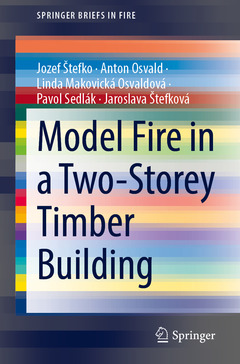Model Fire in a Two-Storey Timber Building, 1st ed. 2021 SpringerBriefs in Fire Series

This book addresses the performance of a multi-storey timber building subjected to a model fire that represents a real, potentially devastating internal fire. Readers will learn about factors concerning fire hazards in buildings; the mechanisms of how fires start and spread; and the degrading impact of fire on wood and wood-based materials, especially their mechanical properties. The book also discusses the fire resistance of timber buildings and the design principles for fire safety, summarised in Eurocodes.
In turn, a fire test on a full-size wooden structure demonstrates the principles discussed. The test makes up an essential part of the book, as to its individual steps: the development, planning, execution and subsequent assessment. This is complemented by detailed temperature monitoring at hundreds of individual spots and the reaction of the wood constructions, illustrated in extensive photo documentation.
The temperature and fire development presented there show the fire's initial mechanism and its further behaviour in a wood construction. The test proved the feasibility of fire protection and safe design of timber buildings, offering insights that can be generally applied in research, material and construction development. Accordingly, the book will be especially useful for architects, building and fire engineers, as well as researchers dealing with the fire performance of timber buildings.
Preface
Foreword
List of Symbols
1.0 A Building and a Fire
2.0 Wood – a Combustible Building Material
2.1 General Characteristics of Wood
2.2 Wood Degradation by Heat Impact (By Fire)
2.2.1 Thermal Degradation of Main Wood Components
2.2.2 Wood Microscopic Structure Changes by High-Temperature Stress
2.2.3 Wood Macroscopic Structure Changes by High-Temperature Stress
2.2.4 Physical Properties of Thermally Degraded Wood
2.2.5 Mechanical Properties of Thermally Degraded Wood
2.2.5.1 Temperature Impact to Bending Strength and to Bending Modulus of Elasticity
2.2.5.2 Temperature Impact to Tension Strength and MOE at Tension Parallel to Grain
2.2.5.3 Temperature Impact to Wood Compression Properties Parallel to Grain
2.2.5.4 Temperature Effect on Shear Strength of Wood
2.2.5.5 Charring Rate Effect to Mechanical Properties of Wood in General
2.3 Fire Resistance of Wooden Structures
2.4 Eurocode 5
2.4.1 Origin and Development of Eurocode Standards Programme
2.4.2 Related European Standards
2.4.3 Design Principles
2.4.4. Examples
2.5 Conclusion
3.0 Full-Size Fire Test of a Wooden Structure
3.1 The Concept of the Full-Size Tests
3.2 Structural Fire Test Scheme of Two-Storey Building
3.3 Construction Process of the Fire-Tested Two-Storey Building
3.4 Photos of the Test Structural Fire
3.5 The Fire Assessment
3.5.1 The Fire Assessment – Ground Floor
3.5.2 The Fire Assessment – First Floor
3.5.3 The Temperature Assessment – the East External Wall
3.5.4 The Temperature Assessment – the West External Wall
3.5.5 The Temperature Assessment – the North External Wall
3.5.6 The Temperature Assessment – the South External Wall
4.0 Summary of the Experiment
Prof. Ing. Jozef Štefko, CSs. works as professor at the Technical University in Zvolen and has a civil engineering degree. He is the author of seven expertise book publications and monographs focusing on wooden building constructions. He is also Co-author of one scientific monograph entitled "Fire Safety in Wooden Buildings". He was the chief member of several national and international research and development projects in the field of wooden building constructions.
Prof. Ing. Anton Osvald, CSc., professor, formerly working at the University of Zilina and the Technical University in Zvolen. In both workplaces, he focused on the instruction and research in fire safety. He was the principal investigator of several grant projects and the author and co-author of several scientific monographs and university textbooks. He held the position of the chairman of the international scientific conference “Wood & Fire Safety”, several times.
doc. Bc. Ing. Linda Makovická Osvaldová, PhD. is Associate Professor in the Department of Fire Engineering at the Faculty of Security Engineering, University of Žilina, Slovakia. In her scientific and educational activities, she deals with the issues of testing of materials used in technological processes and in building constructions, as well as with natural materials in forest fires. She is an active member of both domestic and foreign organizations. She is a member of several editorial boards of foreign and domestic magazines. Her scientific research activities are varied and published both in indexed journals and in indexed conference. She is active in international fora where she has presented the results of various projects. From year 2016 she is in a chairman of the international scientific conference "Wood and Fire Safety".
Ing. Pavol Sedlák, Ph.D., works in the Department of Wood Constructions at the Faculty of Wood Sciences and Technology at the Technical Univer
Discusses how the large-scale wooden building performs in a real fire
Mediates the state-of-the-art knowledge in fire engineering focusing on wooden buildings
Argues the sceptic myths on dangers of wooden buildings in a fire
Date de parution : 08-2021
Ouvrage de 82 p.
15.5x23.5 cm



